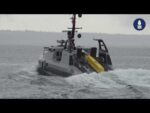The U.S. Coast Guard (USCG) has significantly expanded its presence along the Rio Grande through Operation River Wall—a Department of Homeland Security (DHS)-led initiative aimed at bolstering border security in Texas. This surge includes specialized shallow-water craft and enhanced command-and-control elements to counter illicit cross-border activities in challenging riverine terrain.
Operation River Wall: Strategic Context and Objectives
Launched in early 2024 as part of a broader DHS response to increased unauthorized crossings along the U.S.-Mexico border, Operation River Wall is a multi-agency effort combining federal and state resources to secure key transit corridors. The USCG’s role focuses on riverine interdiction and surveillance operations along a 1,200+ km stretch of the Rio Grande—a complex operational environment marked by narrow channels, variable currents, and dense vegetation.
While U.S. Customs and Border Protection (CBP) leads overall border enforcement efforts, the USCG brings unique capabilities in small boat handling, maritime law enforcement, and interoperable communications—especially valuable in remote or aquatic zones where land-based patrols are limited.
Asset Surge: Shallow-Water Craft and Tactical Teams Deployed
According to official USCG releases and reporting from MarineLog and other outlets, the service has deployed multiple tactical shallow-water craft from its Deployable Specialized Forces (DSF) units. These include:
- 29-foot Response Boat–Small II (RB-S II): Designed for high-speed interdiction in confined waterways; equipped with ballistic protection panels and twin outboard engines for maneuverability in shallow conditions.
- Tactical Law Enforcement Teams (TACLETs): Specially trained boarding teams capable of conducting high-risk interdictions; often embedded with CBP or local law enforcement units for joint operations.
- Portable command-and-control kits: Including satellite-enabled communications gear compatible with CBP’s situational awareness platforms.
The RB-S II vessels are particularly well-suited for this mission profile due to their draft of less than one meter (~0.86 m), allowing access to narrow tributaries where smuggling activity often occurs. Each boat is typically crewed by three personnel trained in pursuit tactics, rules of engagement under Title 10/Title 14 authorities, and night operations using EO/IR sensors.
C4ISR Integration with DHS Border Architecture
A critical enabler for Operation River Wall is integration into DHS’s layered surveillance architecture. The USCG assets are linked into CBP’s Common Operating Picture (COP), leveraging real-time data feeds from:
- Tethered Aerostat Radar Systems (TARS)
- Mobile Surveillance Capability towers (MSC)
- Remote Video Surveillance Systems (RVSS)
This data fusion allows Coast Guard crews to respond rapidly to sensor cues indicating illegal crossings or waterborne smuggling attempts. In some sectors near Laredo and McAllen—where cartel activity has been documented—USCG boats operate as quick reaction forces coordinated through Joint Task Force–North under U.S. Northern Command.
Challenges of Operating on the Rio Grande
The Rio Grande presents significant operational challenges not typically encountered in coastal or open-ocean missions:
- Navigational hazards: shifting sandbars, submerged debris from floods or human activity.
- Sovereignty issues: close proximity to Mexican territory requires precise navigation protocols; any accidental incursion could escalate diplomatically.
- Civilian presence: many areas are adjacent to residential communities or farmland; rules of engagement must account for non-combatant safety during high-speed pursuits.
The USCG crews undergo tailored pre-deployment training at locations such as Camp Lejeune’s Joint Maritime Training Center (JMTC), focusing on inland waterway tactics and interagency coordination drills specific to border environments.
Operational Impact and Future Outlook
DHS officials have credited Operation River Wall with contributing to a measurable reduction in successful waterborne crossings since Q1 2024—though exact interdiction figures remain classified. The operation also serves as a testbed for joint force integration between maritime services like USCG and land-centric agencies such as CBP Border Patrol Tactical Units (BORTAC).
The deployment is expected to continue through at least late FY2024 pending funding extensions under DHS appropriations bills. There is also discussion within Congress about formalizing a permanent riverine capability within Sector Corpus Christi or Sector Lower Mississippi based on lessons learned during this operation.
Conclusion: A New Frontier for Maritime Homeland Defense
The expansion of Operation River Wall marks an evolution in how maritime forces contribute to homeland defense beyond traditional blue-water missions. For the USCG—often seen primarily as a coastal force—the mission underscores its flexibility across domains including inland waterways where hybrid threats blur lines between criminality and national security risks.










